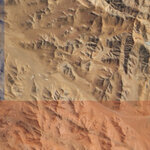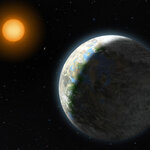Space
What happens when you think you have seen a recent collision between two asteroids but find a bizarre X-shaped object at the head of a comet-like trail of material? You keep looking until you can figure it out.
In January, astronomers thought the new collision they found would have a debris field expanding rapidly, like shrapnel flying from a hand grenade, but when they watched the aftermath using Hubble, they found the opposite; the object was expanding very, very slowly and that it started, not a few days, but nearly a year before the January observations.
"When I saw the…
How do astronomers weigh stars? In most cases stars that are trillions of miles away can't be measured, though astronomers can get a best estimate using numerical models.
But in some instances a star could be measured using inference. If the star has a transit planet, and that planet has a moon, and both of them cross in front of their star, the size and orbit can be measured to learn about the star. Has it been done yet? Well, no, since we have not found a star with both a planet and moon that transit but NASA's Kepler spacecraft should discover…

Human presence in space enable us to do more than just observe Earth from a far. We develop space technology that come in handy here on Earth in numerous applications. Or, as is so touchingly demonstrated in the Chilean miners rescue 'miracle', we learn more about the human species (medical and psychological) so that we can literally help save human lives under extreme conditions here on Earth.
The San Jose mine in Chile as seen from space. Credit: NASA
Satellite images show how desolated the San José mine is, situated north of Copiapó, Chile, in the world’s driest desert, the Atacama. At…
What's 7 billion light years away, equivalent in weight to 800,000,000,000,000 of our Suns and holds hundreds of galaxies? It's the most galaxy cluster ever discovered, that's what.
Astronomers using the South Pole Telescope discovered the behemoth and designated it the rather unspectacular SPT-CL J0546-5345.
Redshift measures how light from a distant object has been stretched by the universe's expansion. Located in the southern constellation Pictor (the Painter), the cluster has a redshift of z=1.07. This puts it at a distance of about 7 billion light-years, meaning…

Two weeks ago we posted a story on Gliese 581g - a planet that was discovered and said to be in the habitable zone of a star. Our comment was that reduced chi-squared statistics may mean that, if there was an error, it would not even exist.
That didn't stop one of the researchers from saying, "Personally, given the ubiquity and propensity of life to flourish wherever it can, I would say that the chances for life on this planet are 100 percent. I have almost no doubt about it." Somewhat shocking for an astronomer to a journalist who was going to repeat it verbatim.
Even more muddy…

A 32-foot asteroid flew between the Earth and the Moon this morning. It was spotted in advance. It did not hit the Earth, but passed about 28,000 miles up. If it had hit the Earth, it would not have done damage. One of this size tends to hit the Earth's atmosphere every 2 years, on average. And, as NASA notes, we get a flyby of this size in the 'tween-Earth-Moon space about once every day.
This particular one passed much closer to Earth than the Moon's distance, and in fact almost to the spacing of our Earth-launched geosynchronos satellites. While the Moon…

Astronomers are certainly not strangers to manipulating public relations through mass media - they write reasonable papers and then encourage the press to go nuts with it. Witness the recent arXiv paper by Vogt, Butler, et al on Gliese 581g, should it even exist, which reads
it is important to keep in mind that, though all 6 planets presented here are well-supported by the calculated reduced chi-squared statistics and also by several different variants of FAP statistics, and the entire 6-planet system is consistent with the combined data set from both teams, caution is warranted…

A new report in Nature Geoscience says there may be large deposits of carbonate sedimentary rocks a few miles beneath the surface of Mars.
If substantial carbonate minerals exist it might indicate a past surface environment with carbon dioxide, in contrast to its current acidic (and inhospitable) state.
Researchers Joseph Michalski and Paul B. Niles found evidence for carbonate bedrock deep under the Martian crust and believe the ancient sediments were linked to a volcanic eruption by the Syrtis Major volcano.
If the volcano did bury the carbonates and a meteor exposed them, the…
"TAU researcher confirms oily "water" on a Saturn moon", so reads the email that crossed my desk. Then I learned why no mountain or landform on Titan can ever be taller than 6,200 feet. The reason surprised me, but first, the backstory about the paper.
The Cassini-Huygens mission to Saturn has generated many exciting discoveries about the planet and its moons - and now a Tel Aviv University (TAU) researcher associated with the project has determined that Saturn's moon Titan includes a unique population of lakes.
Prof. Akiva Bar-Nun of Tel Aviv University says that, instead of…
A persistent hypothesis is that perhaps life did not 'originate' on Earth at all, perhaps its building blocks came from space.
In April, the public, fed by astronomy's runaway hype train, were excited by the discovery of water on an asteroid - but it was exciting, it was just the conjecture that followed was a little cloying.
Now the same researchers have revealed that asteroid 65 Cybele also contains traces of water and, they say, complex, long-chained molecules. 65 Cybele is somewhat larger than asteroid 24 Themis; Cybele has a diameter of 290 km (180 miles) while Themis has a…